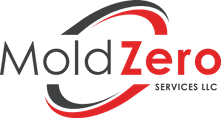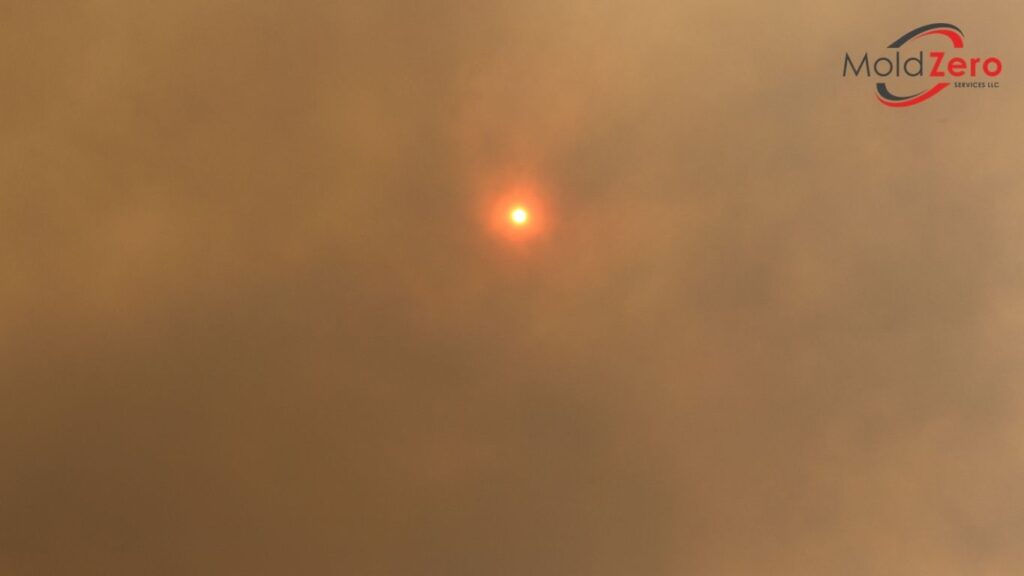Wildfires & Mold: The Hidden Danger in Los Angeles
Wildfires are a significant and often devastating reality for communities across California, and Los Angeles is no stranger to their impact. The immediate dangers of flames, smoke, and compromised air quality are widely recognized, prompting evacuations and extensive safety measures.
However, amidst the visible challenges that wildfires present, there’s a less obvious, yet considerable, threat that can emerge in their aftermath: mold growth within properties, even those seemingly untouched by fire.
Mold is a Real Hidden Danger to Your Property
Property owners in Los Angeles, whether homeowners, landlords, or business owners, need to be aware of this hidden danger. Mold can quietly establish itself in the altered conditions left behind by wildfire events, leading to potential property issues and affecting the indoor environment.
Understanding this connection is the first step in protecting your investment and supporting the well-being of those who occupy the space. Unlike climates where high ambient humidity is a constant concern, the mold risk in Los Angeles properties after a wildfire is primarily driven by specific, event-related moisture issues, though rare occasions of elevated local humidity can sometimes play a small contributing role.
The Unexpected Connection: Wildfires and Increased Mold Risk
It might not be immediately intuitive how wildfires, associated with fire and dryness, can lead to mold, which thrives in moisture. However, the aftermath of a wildfire event creates several specific conditions that can inadvertently introduce or trap moisture within properties, promoting mold growth even when the general climate is not particularly humid:
Firefighting Efforts
The extensive use of water and fire retardants to control blazes can saturate the ground, surrounding areas, and even the exteriors and interiors of properties near the fire zone. This is a primary source of significant, localized moisture that can penetrate building materials.
Power Outages
Wildfires often cause power disruptions, which can last for extended periods. This leads to the shutdown of HVAC systems, air conditioning, and dehumidifiers that normally help regulate indoor temperature and manage any existing moisture within a property.
Closed-Up Properties & Evacuation
To protect interiors from smoke and ash, occupants are often advised to keep windows and doors tightly closed. Properties may also be left vacant during mandatory or voluntary evacuations. This lack of natural or mechanical ventilation prevents air exchange.
The consequence is that any existing indoor moisture or moisture introduced by other means becomes trapped and can accumulate within the sealed environment.
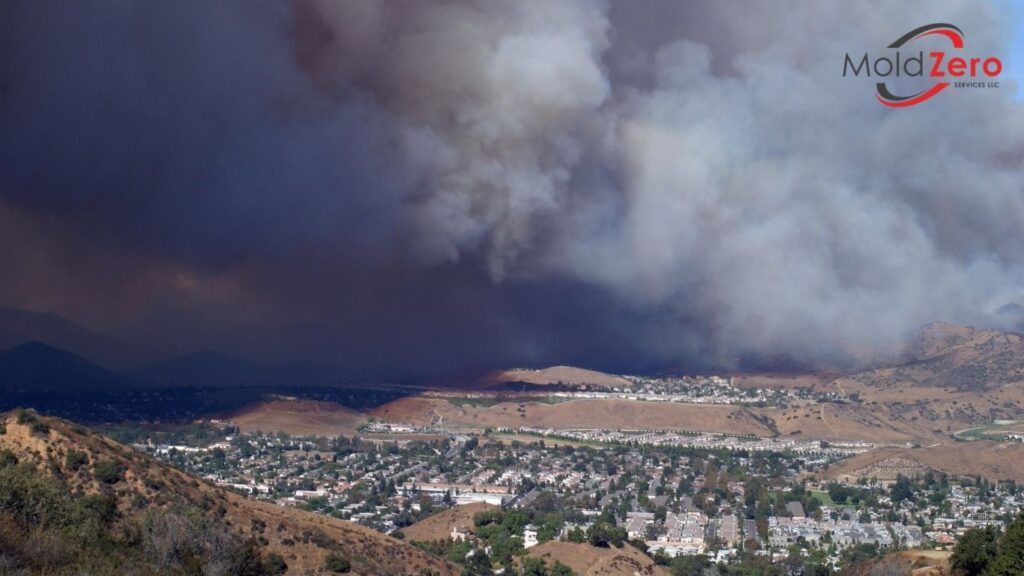
Minor Property Damage
Even if a property isn’t directly burned, embers, falling debris, or strong winds associated with the fire can cause minor damage to roofs, gutters, windows, or siding. These seemingly small issues can create overlooked entry points for water infiltration from subsequent weather events.
These vulnerabilities can lead to hidden moisture problems that might not be immediately visible but create prime conditions for mold growth.
These factors, individually or in combination, can introduce or trap moisture within a property, creating the damp conditions that mold needs to grow and flourish, independent of the typical Los Angeles climate. The presence of wildfire smoke and ash residue can also contribute organic matter that mold can feed upon if moisture is present on surfaces.
How Wildfire Aftermath Can Create Ideal Conditions for Mold
Let’s explore in more detail how the specific conditions following a wildfire event in Los Angeles can significantly elevate the risk of mold by introducing or trapping moisture:
Water Damage from Fire Suppression
While essential for saving properties, the sheer volume of water used by firefighters can have unintended consequences, particularly in saturating building materials. Water can seep into foundations, pool around the exterior, and even penetrate walls and roofs of buildings near the fire perimeter.
This saturation can go unnoticed, particularly if the focus is on immediate fire-related damage. Building materials like wood framing, drywall, insulation, and flooring can absorb this moisture like a sponge.
If these materials remain wet for more than 24-48 hours, regardless of the ambient air conditions, the likelihood of mold growth increases dramatically. This isn’t limited to properties directly in the fire’s path; buildings in adjacent areas affected by water runoff or extensive dousing efforts are also at significant risk from this direct water exposure.

Reduced Ventilation and Trapped Indoor Moisture
During wildfire events, authorities typically advise residents to seal their homes to prevent smoke and ash from entering. While crucial for maintaining better indoor air quality during the smoke event itself, keeping windows and doors closed for extended periods significantly reduces natural ventilation and prevents air exchange.
This lack of fresh air movement traps air indoors, and any moisture present from normal indoor activities (showering, cooking, even breathing) or introduced by other means (like minor leaks or water residue) can become concentrated.
If the power is out, mechanical ventilation systems like exhaust fans and air conditioning are non-functional, and dehumidifiers stop working. This stagnant, trapped, potentially moisture-laden air inside a sealed-up property creates an ideal, undisturbed environment for mold spores (which are naturally present in the air and can enter via smoke) to settle and begin to grow on damp surfaces.
It’s the lack of ventilation allowing moisture to linger, rather than high ambient humidity, that poses the primary risk here in Los Angeles in this context.
Compromised Building Envelopes
Wildfires can affect properties in subtle ways that compromise their ability to keep moisture out in the long term. High winds can loosen shingles or tiles on roofs. Falling embers, even if they don’t start a fire, can burn small holes in screens or vulnerable exterior materials. Fire retardants can sometimes affect the integrity of roofing or siding materials over time.
These seemingly minor points of damage can become major issues when the next rain event occurs or when sprinklers run, allowing water to seep in. Water can infiltrate wall cavities, attics, or crawl spaces through these compromised areas, leading to hidden moisture problems and subsequent mold growth that may not become visible until much later.
The stress and focus following a wildfire may mean these minor damages are overlooked during initial assessments, creating long-term vulnerabilities to moisture intrusion that can lead to mold.
Recognizing the Hidden Signs of Mold After a Wildfire
Given the indirect ways mold can manifest after a wildfire, and its ability to grow in hidden spaces, it’s important for Los Angeles property owners to be vigilant and know what to look for. Mold doesn’t always announce its presence with visible growth, especially in hidden cavities or behind finishes compromised by a fire event.
Subtle Indicators that May Point to Mold:
Musty Odors: One of the most common indicators of hidden mold growth is a persistent, earthy, or musty smell, often described as smelling like old, damp paper or decaying leaves. If you notice such an odor upon returning to or entering your property after a wildfire event, particularly in areas that may have been exposed to water from firefighting, remained closed up, or sustained minor damage, it warrants further investigation.
Visible Discoloration or Staining: While obvious mold patches are a clear sign, look for unexplained stains, water marks, or discoloration on walls, ceilings, floors, or around windows. These could indicate past or present moisture issues that may have led to mold growth, even if the mold itself isn’t immediately identifiable as fuzzy colonies, especially if it’s mixed with soot or ash residue.
Peeling or bubbling paint or wallpaper can also be a sign of moisture trapped behind the surface, providing conditions for mold growth.
Warped or Swelling Materials: Pay attention to structural materials like drywall, wood trim, or flooring that appear warped, buckling, or swollen. This physical change is often a sign that these materials have absorbed significant moisture, creating conditions favorable for mold development within them.
New or Worsening Sensitivities: While not a definitive diagnosis of mold presence, occupants experiencing new or unexplained stuffiness, sneezing, coughing, irritated eyes, or other sensitivities upon spending time in the property after a wildfire event should consider mold as a possible contributing factor. These symptoms can sometimes be related to the presence of mold spores or other environmental factors present after a fire.
It’s particularly important to inspect areas that might have been exposed to water from firefighting efforts, areas that remained closed up and unventilated for long periods, basements, attics, crawl spaces, and areas around windows and exterior walls that might have sustained minor damage.
Why Professional Mold Remediation is Essential After a Wildfire Threat
Given the potential for hidden moisture sources introduced by firefighting or lack of ventilation, the widespread distribution of spores in a post-wildfire environment (including those carried by smoke or disturbed during cleanup), and the potential mix of mold with other residues like soot and ash, professional mold remediation is not just recommended, but essential.
Attempting to clean up mold in this context without the right expertise, protective gear, and specialized equipment is particularly risky. You could inadvertently spread mold spores further, disturb other materials potentially present after a fire, and fail to address the underlying moisture issue or hidden growth effectively, leading to the mold problem returning.
Professional mold removal experts in Los Angeles have the training and tools to properly assess the situation, contain the work area to prevent cross-contamination, address the mold thoroughly, and verify that the problem has been resolved, even when the moisture sources are complex or hidden due to the wildfire event aftermath.
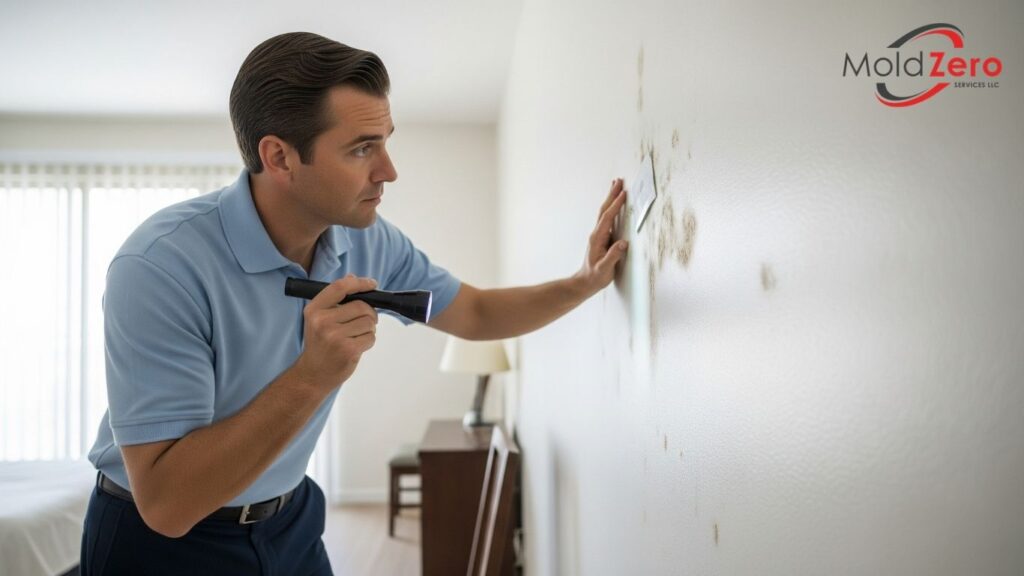
Mold Zero’s Solution for Post-Wildfire Mold Concerns in Los Angeles
At Mold Zero Services, we understand the unique stresses and challenges that come with wildfire season in Los Angeles. If you suspect mold has become a hidden issue in your property following a fire event or prolonged closure, we are here to help with expert, efficient, and reliable mold remediation services.
Our process is specifically designed to address mold contamination thoroughly and with minimal impact on your property, providing peace of mind during a time of recovery. We offer a comprehensive solution that goes beyond superficial cleaning. Our goal is to provide a lasting resolution to your mold concerns, addressing the moisture-related consequences of the wildfire aftermath.
Our Proven 5-Step Process Addresses Post-Wildfire Mold:
Our unique, advanced 5-step process is highly effective for addressing mold issues arising from wildfire aftermath, regardless of the specific moisture source:
- 1) Initial HEPA Vacuuming: We begin by carefully vacuuming all affected surfaces using state-of-the-art HEPA filtered vacuums. This is crucial for capturing microscopic mold spores and other fine particles, like ash and soot, that may be present, ensuring they are removed from the environment and contained before the treatment phase. Unlike standard vacuums, professional HEPA filters capture the tiny particles often linked to mold concerns.
- 2) Hygienic Damp Wiping: Following the initial vacuuming, our trained technicians meticulously wipe down surfaces using specialized techniques and solutions. This step helps to remove any remaining surface residues, including settled spores, ash, and other particulates, preparing the surfaces for our specialized treatments. It’s a detailed process that complements the HEPA vacuuming for a thorough initial cleaning, addressing residues left by both mold and fire aftermath.
- 3) Spor-Klenz® Fogging: This is where our process significantly differs from many others and is highly effective for reaching mold caused by trapped moisture or firefighting water. We apply our powerful, yet carefully selected, treatment agent called Spor-Klenz via a specialized fogging technique.
- This allows the treatment to reach all surfaces within the affected area, including hard-to-access spots and interstitial spaces (like inside walls or under flooring) without requiring demolition.
- Spor-Klenz is designed to neutralize mold on contact, addressing the established mold colonies and airborne spores effectively throughout the contained space, even where water may have seeped or air was trapped. The fogging application ensures comprehensive coverage that manual cleaning cannot achieve, effectively addressing mold in locations created by post-wildfire conditions.
- 4) Goldshield® Barrier Fogging: After the Spor-Klenz treatment, we apply Goldshield using the same fogging method. Goldshield creates a durable, invisible barrier on treated surfaces. This innovative step is crucial for prevention.
The Goldshield barrier actively helps inhibit future mold growth on the surfaces it is applied to, providing long-lasting protection and significantly reducing the likelihood of the mold problem returning, even if the area was previously prone to moisture from wildfire effects. This preventative measure is a key part of our commitment to resolving the issue comprehensively and supporting the long-term well-being of your indoor environment after a stressful event.
5) Post-Remediation HEPA Vacuuming: As a final step, we perform another thorough HEPA vacuuming of the treated areas. This ensures that any particles that may have been dislodged during the process, including neutralized spores or settled residue, are captured and removed from the air and surfaces. This final cleaning step helps ensure the treated environment is left in a clean and settled state, free from mold particles and minimizing remaining fine debris from the wildfire.
This non-destructive approach means that even if your property has already experienced stress or minor damage from a wildfire, our mold remediation process won’t add to that burden through extensive tear-out. Our process is typically completed in just hours, supporting a faster and less disruptive recovery period for you and your property.
Fast, Minimally Invasive Recovery
Recovering after a wildfire is a challenging process, and dealing with secondary issues like mold adds to the burden. Our fast, minimally invasive mold remediation service helps alleviate some of that stress.
By avoiding the extensive demolition and reconstruction often associated with traditional methods, we can address the mold issue efficiently, allowing you to focus on other aspects of restoring your property and life. Our skilled professionals, drawing on experience from over 1000 mold remediation jobs and holding NORMI certifications, are equipped to handle complex situations quickly and effectively, getting your property back to a better state sooner.
Verification and Guarantee Offer Certainty
In times of uncertainty following a wildfire, we provide certainty regarding the mold status of your property. Upon completion of our comprehensive remediation process, we arrange for independent, third-party laboratory testing of air and surface samples taken from the treated areas. This provides objective verification of the effectiveness of our work. You receive the lab results directly from the lab, giving you confidence in the outcome based on unbiased analysis.
Robust 1-Year Guarantee
Furthermore, we stand behind our service with a robust 1-year guarantee against new mold growth in the areas we have treated, provided there are no new water intrusions. This guarantee underscores our confidence in our process and provides you with significant peace of mind, knowing that we are committed to resolving your mold problem stemming from post-wildfire conditions for the long term. Our NORMI certification also signifies our adherence to professional standards and ongoing training in effective mold remediation techniques.
Trusted Solutions for Your Property and Indoor Environment
Our commitment extends to using products that we have carefully considered and would trust in our own family environments. This philosophy guides our selection of treatments like Spor-Klenz and Goldshield, ensuring we use solutions suitable for properties where people live and work.
This is especially important when occupants are returning to their homes or businesses after the stress of evacuation, the presence of smoke and ash, and the potential for mold growth. We prioritize methods that support the well-being of the indoor environment.
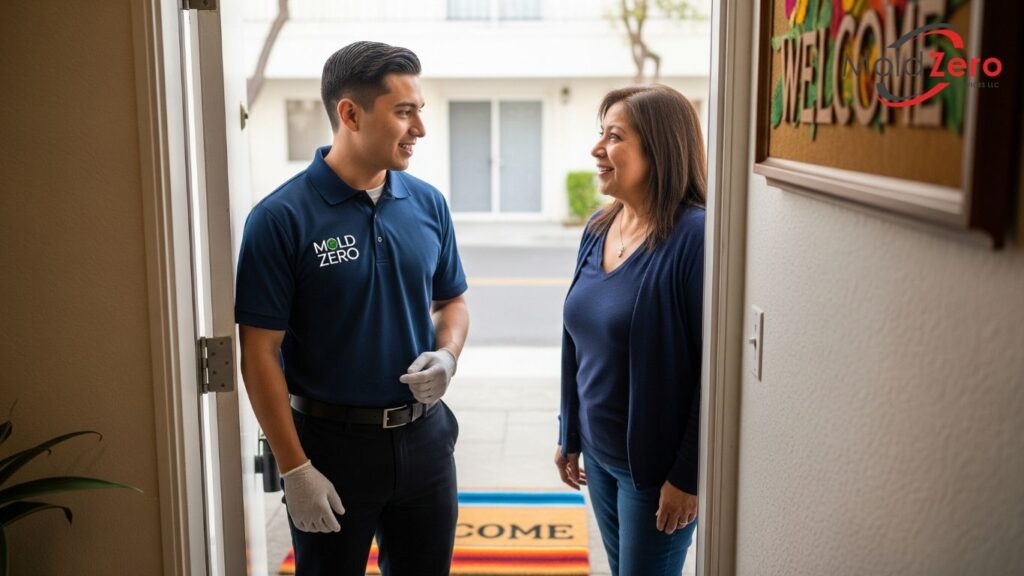
Don’t Let Wildfire Aftermath Hide a Mold Problem in Los Angeles
The dangers of wildfires in Los Angeles are clear, but the potential for increased mold risk in their wake, caused by firefighting water, lack of ventilation in closed spaces, power outages affecting moisture control, and hidden structural damage, is a hidden threat that demands attention.
Being vigilant for the subtle signs of mold and acting quickly is crucial to prevent the problem from becoming more extensive and impacting your property and its indoor environment.
Mold Zero Services is your expert partner for addressing post-wildfire mold concerns in Los Angeles. Our fast, minimally invasive, guaranteed, and independently verified mold remediation process offers a comprehensive and reliable solution. Trust our experienced, NORMI Certified professionals to address this hidden danger effectively, providing you with peace of mind as you recover and restore your property.
Don’t ignore the potential for mold after a wildfire event in Los Angeles. Protect your property and those who occupy it by addressing mold concerns promptly and professionally.
Contact Mold Zero Services Immediately for a Free Inspection and Quote
Call us today at (626) 671-8885 to speak with an expert about your post-wildfire mold concerns and schedule your free assessment, or fill out our online form for a prompt response. Take the essential step toward ensuring your property is free from the hidden threat of mold after a wildfire event.
